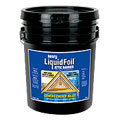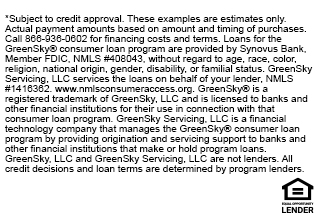LiquidFoil™ Attic Barrier
Why choose Henry LiquidFoil™?
Considering other energy-saving upgrades to your home? Choosing Henry LiquidFoil™ provides a less expensive, energy saving solution that can lead to long-term results. Below offers a comprehensive comparison of LiquidFoil™ to sheet-applied, attic insulation and other liquid barriers.
LiquidFoil™ Attic Barrier vs. sheet applied or foil radiant barriers
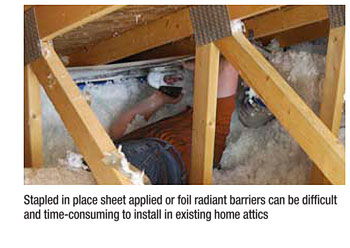 Less expensive
Less expensive
Sheet applied or foil radiant barriers can cost up to 5X more per square foot than LiquidFoil™ Attic Barrier.
Faster, easier application
Sheet applied or foil radiant barriers require two people for installation and can take up to 3X as long. LiquidFoil™ requires only one person.
Seamless protection
Unlike sheet applied or foil radiant barriers, LiquidFoil™ Attic Barrier provides continuous coverage with no gaps, seams or stops.
No interference with reception
Unlike many sheet applied or foil radiant barriers, LiquidFoil™ Attic Barrier will not interfere with cell phone signals or over-the-air antenna reception.
LiquidFoil™ Attic Barrier vs. insulation
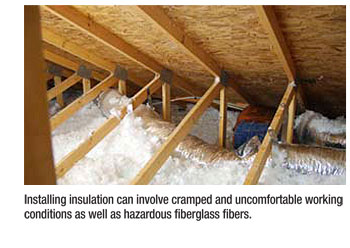 Less expensive
Less expensive
Insulation can cost up to 6X more than Henry LiquidFoil™ Attic Barrier.
Blocks radiant heat
Designed to block airflow, insulation only slows radiant heat down – Henry LiquidFoil™ Attic Barrier blocks up to 80% of it. In some cases, applying LiquidFoil™ Attic Barrier achieves better results than attic insulation.
Better than insulation upgrades alone
A comprehensive ORNL1 study comfirms that homes with attic air ducts and R-19 insulation in the attic floor will benefit from even greater energy savings with Henry LiquidFoil™ Attic Barrier than they would from upgrading the insulation to code levels.
Even better with insulation upgrades
LiquidFoil™ complements a home’s insulation and makes it perform more efficiently. When attic floor insulation is upgraded from R-19 to code levels and LiquidFoil™ Attic Barrier is applied, energy savings will be even greater.
LiquidFoil™ Attic Barrier vs. other liquid barriers
Lower e-rating than most
LiquidFoil™ Attic Barrier has a lower emissivity rating than many other liquid radiant heat barriers.
No mixing required
Unlike many competing liquid radiant heat barriers, there’s no need to worry about mixing Part A with Part B at specified rates, saving time and headaches.
No airborne aluminum powder
LiquidFoil™ eliminates the use of aluminum powder (Part B) that can become airborne.
LiquidFoil™ Attic Barrier
Potential energy savings with LiquidFoil™
No matter how much insulation there is in the attic, homeowners are still spending a lot of money on energy to keep their home cool in the summer and warm in the winter. For example, when cold 78° air is blown through air conditioning ducts in an attic that can reach temperatures well over 100°, even extra insulation is no match for the job. Cooling equipment has to work harder and longer. However, there is a simple and cost effective solution that can be applied in less than one day.
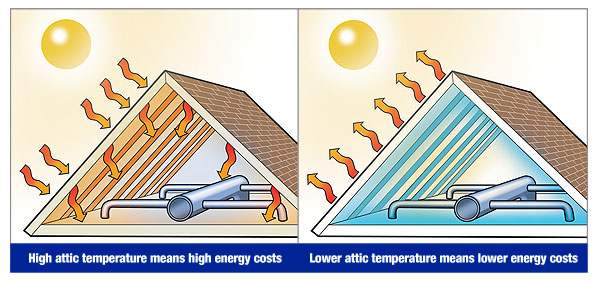
High attic temperature means high energy costs
Radiant heat from the sun penetrates the roof, warming interior attic surfaces below. The heat continues to radiate downward, through the ceiling and into the house. The air conditioning system – particularly one with poorly insulated ductwork in the attic – works harder, driving energy costs higher.
Lower attic temperature means lower energy costs
Radiant heat from the sun still penetrates the roof, but LiquidFoil™ Attic Barrier keeps up to 80% of it from entering the attic – and the rest of the house below. Air conditioning systems work much more efficiently, cutting costs by up to 15%.
Savings in winter, too
During the winter months, radiant heat produced by a heating system goes into the attic and escapes through the roof. LiquidFoil™ Attic Barrier helps to trap that heat inside, keeping the house warmer for less money.
LiquidFoil™ Attic Barrier
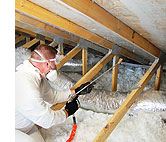 The energy-saving attic barrier from Henry – a leader in Building Envelope Systems
The energy-saving attic barrier from Henry – a leader in Building Envelope Systems
Henry LiquidFoil™ Attic Barrier is a radiant heat control coating that keeps heat out of a building during the summer and in during the winter. By keeping up to 84% of radiant heat from entering or escaping a building, LiquidFoil™ Attic Barrier can cut energy consumption and costs significantly. And it’s as easy to apply as paint and dries quickly to a shiny, metallic finish.
Consider Henry LiquidFoil™ Attic Barrier first! Compared to other radiant barriers and insulation, Henry LiquidFoil™ Attic Barrier saves time and money, with comparable energy-saving results.
Potential energy savings with LiquidFoil™
|
||||||
Radiant barriers are installed in homes -- usually in attics -- primarily to reduce summer heat gain and reduce cooling costs. The barriers consist of a highly reflective material that reflects radiant heat rather than absorbing it. They don't, however, reduce heat conduction like thermal insulation materials.
How They Work
Heat travels from a warm area to a cool area by a combination of conduction, convection, and radiation. Heat flows by conduction from a hotter location within a material or assembly to a colder location, like the way a spoon placed in a hot cup of coffee conducts heat through its handle to your hand. Heat transfer by convection occurs when a liquid or gas -- air, for example -- is heated, becomes less dense, and rises. As the liquid or gas cools, it becomes denser and falls. Radiant heat travels in a straight line away from any surface and heats anything solid that absorbs its energy.
Most common insulation materials work by slowing conductive heat flow and -- to a lesser extent -- convective heat flow. Radiant barriers and reflective insulation systems work by reducing radiant heat gain. To be effective, the reflective surface must face an air space.
When the sun heats a roof, it's primarily the sun's radiant energy that makes the roof hot. Much of this heat travels by conduction through the roofing materials to the attic side of the roof. The hot roof material then radiates its gained heat energy onto the cooler attic surfaces, including the air ducts and the attic floor. A radiant barrier reduces the radiant heat transfer from the underside of the roof to the other surfaces in the attic.
A radiant barrier works best when it is perpendicular to the radiant energy striking it. Also, the greater the temperature difference between the sides of the radiant barrier material, the greater the benefits a radiant barrier can offer.
Radiant barriers are more effective in hot climates than in cool climates, especially when cooling air ducts are located in the attic. Some studies show that radiant barriers can reduce cooling costs 5% to 10% when used in a warm, sunny climate. The reduced heat gain may even allow for a smaller air conditioning system. In cool climates, however, it's usually more cost-effective to install more thermal insulation than to add a radiant barrier.
Types of Radiant Barriers
Radiant barriers consist of a highly reflective material, usually aluminum foil, which is applied to one or both sides of a number of substrate materials such as kraft paper, plastic films, cardboard, oriented strand board, and air infiltration barrier material. Some products are fiber-reinforced to increase durability and ease of handling.
Radiant barriers can be combined with many types of insulation materials in reflective insulation systems. In these combinations, radiant barriers can act as the thermal insulation's facing material.
Installation
A radiant barrier's effectiveness depends on proper installation, so it's best to use a certified installer. If you choose to do the installation yourself, carefully study and follow the manufacturer’s instructions and safety precautions and check your local building and fire codes. The reflective insulation trade association also offers installation tips.
It's easier to incorporate radiant barriers into a new home, but you can also install them in an existing home, especially if it has an open attic. In a new house, an installer typically drapes a rolled-foil radiant barrier foil-face down between the roof rafters to minimize dust accumulation on the reflective faces (double-faced radiant barriers are available). This is generally done just before the roof sheathing goes on, but can be done afterwards from inside the attic by stapling the material to the bottom of the rafters.
When installing a foil-type barrier, it's important to allow the material to "droop" between the attachment points to make at least a 1.0 inch (2.5 cm) air space between it and the bottom of the roof. Foil-faced plywood or oriented strand board sheathing is also available.
Note that reflective foil will conduct electricity, so workers and homeowners must avoid making contact with bare electrical wiring. If installed on top of attic floor insulation, the foil will be susceptible to dust accumulation and may trap moisture in fiber insulation, so it is strongly recommended that you NOT apply radiant barriers directly on top of the attic floor insulation.
